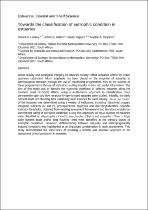JavaScript is disabled for your browser. Some features of this site may not work without it.
- ResearchSpace
- →
- Research Publications/Outputs
- →
- Journal Articles
- →
- View Item
| dc.contributor.author |
Lemley, DA

|
|
| dc.contributor.author |
Adams, JA

|
|
| dc.contributor.author |
Taljaard, Susan

|
|
| dc.contributor.author |
Strydom, NA

|
|
| dc.date.accessioned | 2016-03-04T11:44:40Z | |
| dc.date.available | 2016-03-04T11:44:40Z | |
| dc.date.issued | 2015-10 | |
| dc.identifier.citation | Lemley, DA, Adams, JA, Taljaard, S and Strydom, NA. 2015. Towards the classification of eutrophic condition in estuaries. Estuarine, Coastal and Shelf Science, vol. 164, pp. 221-232 | en_US |
| dc.identifier.issn | 0272-7714 | |
| dc.identifier.uri | http://www.sciencedirect.com/science/article/pii/S0272771415300408 | |
| dc.identifier.uri | http://hdl.handle.net/10204/8455 | |
| dc.description | Copyright: 2015 Elsevier. Due to copyright restrictions, the attached PDF file only contains the abstract of the full text item. For access to the full text item, please consult the publisher's website. The definitive version of the work is published in Estuarine, Coastal and Shelf Science, vol. 164, pp. 221-232 | en_US |
| dc.description.abstract | Water quality and ecological integrity of estuaries closely reflect activities within the entire upstream catchment. Much emphasis has been placed on the response of estuaries to anthropogenic stressors through the use of monitoring programmes. Key to the success of these programmes is the use of indicators, as they transform data into useful information. The aim of this study was to identify the eutrophic condition of selected estuaries along the southern coast of South Africa, using a multi-metric approach to classification. Four permanently open and five temporarily open/closed estuaries were studied. Initially, the daily nutrient loads and flushing time variability were assessed for each estuary. Next, the “state” of the estuaries was determined using a variety of indicators, including: dissolved oxygen, inorganic nutrients (N and P), phytoplankton, epiphytes and microphytobenthos. Specific indicator thresholds, obtained from existing assessment frameworks and literature, enabled an incremental rating of eutrophic condition. Using this approach, an equal number of estuaries were classified as oligotrophic (‘Good’), mesotrophic (‘Fair’) and eutrophic (‘Poor’). High daily nutrient loads and/or long flushing times were identified as the primary causes of eutrophic conditions. However, differentiating between naturally and anthropogenically induced symptoms was highlighted as an important consideration in such assessments. This study demonstrated the importance of adopting a holistic and adaptive approach to the assessment of eutrophication in estuaries. | en_US |
| dc.language.iso | en | en_US |
| dc.publisher | Elsevier | en_US |
| dc.relation.ispartofseries | Workflow;15486 | |
| dc.subject | Assessment methods | en_US |
| dc.subject | Biomass | en_US |
| dc.subject | Estuary | en_US |
| dc.subject | Eutrophication | en_US |
| dc.subject | Microalgae | en_US |
| dc.title | Towards the classification of eutrophic condition in estuaries | en_US |
| dc.type | Article | en_US |
| dc.identifier.apacitation | Lemley, D., Adams, J., Taljaard, S., & Strydom, N. (2015). Towards the classification of eutrophic condition in estuaries. http://hdl.handle.net/10204/8455 | en_ZA |
| dc.identifier.chicagocitation | Lemley, DA, JA Adams, Susan Taljaard, and NA Strydom "Towards the classification of eutrophic condition in estuaries." (2015) http://hdl.handle.net/10204/8455 | en_ZA |
| dc.identifier.vancouvercitation | Lemley D, Adams J, Taljaard S, Strydom N. Towards the classification of eutrophic condition in estuaries. 2015; http://hdl.handle.net/10204/8455. | en_ZA |
| dc.identifier.ris | TY - Article AU - Lemley, DA AU - Adams, JA AU - Taljaard, Susan AU - Strydom, NA AB - Water quality and ecological integrity of estuaries closely reflect activities within the entire upstream catchment. Much emphasis has been placed on the response of estuaries to anthropogenic stressors through the use of monitoring programmes. Key to the success of these programmes is the use of indicators, as they transform data into useful information. The aim of this study was to identify the eutrophic condition of selected estuaries along the southern coast of South Africa, using a multi-metric approach to classification. Four permanently open and five temporarily open/closed estuaries were studied. Initially, the daily nutrient loads and flushing time variability were assessed for each estuary. Next, the “state” of the estuaries was determined using a variety of indicators, including: dissolved oxygen, inorganic nutrients (N and P), phytoplankton, epiphytes and microphytobenthos. Specific indicator thresholds, obtained from existing assessment frameworks and literature, enabled an incremental rating of eutrophic condition. Using this approach, an equal number of estuaries were classified as oligotrophic (‘Good’), mesotrophic (‘Fair’) and eutrophic (‘Poor’). High daily nutrient loads and/or long flushing times were identified as the primary causes of eutrophic conditions. However, differentiating between naturally and anthropogenically induced symptoms was highlighted as an important consideration in such assessments. This study demonstrated the importance of adopting a holistic and adaptive approach to the assessment of eutrophication in estuaries. DA - 2015-10 DB - ResearchSpace DP - CSIR KW - Assessment methods KW - Biomass KW - Estuary KW - Eutrophication KW - Microalgae LK - https://researchspace.csir.co.za PY - 2015 SM - 0272-7714 T1 - Towards the classification of eutrophic condition in estuaries TI - Towards the classification of eutrophic condition in estuaries UR - http://hdl.handle.net/10204/8455 ER - | en_ZA |






